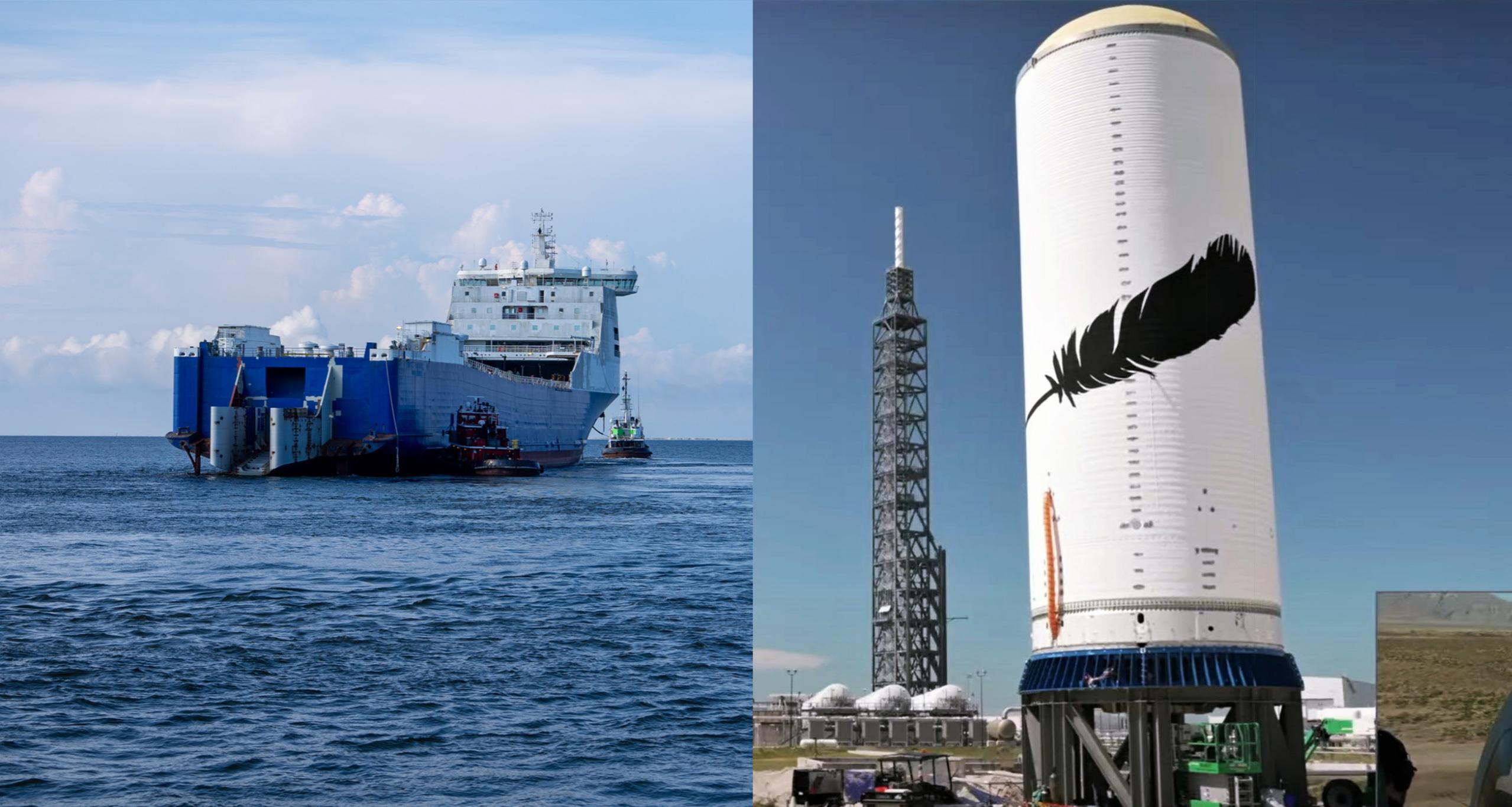
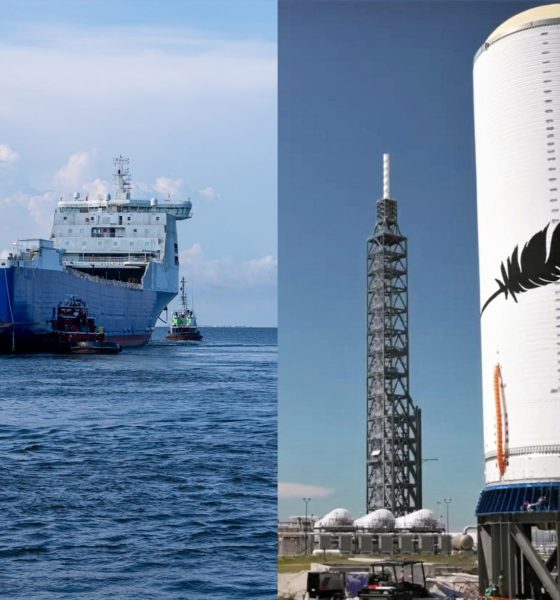
News
Blue Origin scraps New Glenn recovery ship, finishes first ‘test tank’
After four years of halting work, Blue Origin has fully abandoned a transport ship it once intended to convert into a landing platform for its orbital-class New Glenn rocket.
Known as Stena Freighter at the time of sale, Blue Origin purchased the ship for an undisclosed sum – likely several million dollars – sometime in mid-2018. Aside from a flashy, December 2020 re-christening ceremony in which Blue Origin owner Jeff Bezos named the vessel Jacklyn after his late mother, the private aerospace company left the ship largely untouched in a Florida port. Small teams of workers would occasionally work on retrofitting the roll-on/roll-off cargo ship for a future life as a rocket recovery asset but made very little visible progress despite working on Jacklyn for several years.
Now, a few months after a Blue Origin spokesperson first acknowledged that the company was evaluating “different options” for New Glenn booster recovery, Jacklyn has left Florida’s Port of Pensacola for the Texan Port of Brownsville, where documents show that the ship will be scrapped.
According to an unconfirmed report, Blue Origin may ultimately use the same contractors as SpaceX to turn existing barges into ocean-going rocket-landing platforms. Blue Origin had hoped that a large, keeled ship would allow it to launch New Glenn and still recover its expensive booster even if seas were stormy downrange. However, after 107 successful SpaceX Falcon booster landings on flat-bottomed barges that are exceptionally sensitive to wave conditions, just a tiny fraction of launches have been delayed by the ocean. Further, SpaceX has only lost one booster to waves, and it solved that problem by developing a relatively cheap robot. With the benefit of hindsight, it’s not hard to see why Blue Origin changed its mind.
Much like SpaceX’s next-generation Starship rocket, Blue Origin began work on its semi-reusable New Glenn rocket in the early 2010s. Jeff Bezos publicly revealed New Glenn just a few weeks before CEO Elon Musk’s long-planned September 2016 reveal of SpaceX’s next rocket, then known as the Interplanetary Transport System (ITS). Both were massive, meant to be powered by huge new methane/oxygen-fueled engines, and designed from the ground up with some degree of reusability in mind.
But with fairly different designs and wildly different development philosophies, the paths of Blue Origin and SpaceX have only gotten further apart over the last six years. SpaceX thoroughly redesigned its next-generation rocket multiple times before throwing out a large portion of that prior work and settling on an unexpected stainless steel variant that CEO Elon Musk christened Starship in late 2018. Further differentiating the companies, SpaceX began work on steel prototypes almost immediately and successfully built and flew a scrappy pathfinder – powered by an early version of the same Raptor engine meant for Starship – less than a year later.
SpaceX then improvised a factory out of a series of tents and began churning out and testing dozens of more refined prototypes, seven of which would go on to perform flight tests between August 2020 and May 2021. SpaceX’s last test flight ended with a full-size steel Starship prototype successfully landing after launching to an altitude of 10 kilometers (~6.2 mi). Testing slowed considerably after that success but SpaceX appears to have begun ramping up again as it begins to test a Starship (S24) and Super Heavy booster prototype (B7) that have a shot at supporting the rocket’s first orbital launch attempt.
That orbital launch debut has been more or less continuously delayed for years and is about 20 months behind a tentative schedule Musk first sketched out (albeit for a drastically different rocket design) in 2016. Technically, the same is true for Blue Origin, which also said that it intended to debut New Glenn as early as 2020. However, while SpaceX can point to the instability of Starship’s design before 2019 as a fairly reasonable excuse for delays, the general characteristics of New Glenn’s design appear to be virtually unchanged despite its many delays. The smaller rocket – 7m (23 ft) wide and 98m (322 ft) tall to Starship’s 9m (30 ft) width and ~119m (~390 ft) height – will still use traditional aluminum alloys for most of its structures, will be powered by seven BE-4 engines, will land on several deployable legs, will have an expendable upper stage powered by two BE-3U engines, and will be topped with a large composite payload fairing.
Blue Origin canceled plans for a smaller interim fairing, abandoned plans to land the booster on a moving ship, and tweaked the booster’s landing legs and a few other attributes, but New Glenn is otherwise (visibly) unchanged from its 2016 reveal. Ultimately, that makes it even stranger that Blue Origin has done practically zero integrated testing of any major New Glenn components. Only in 2022 did the company finally complete and test a New Glenn payload fairing. Blue may have also built and tested a partial booster interstage, which the New Glenn upper stage will attach and deploy from.
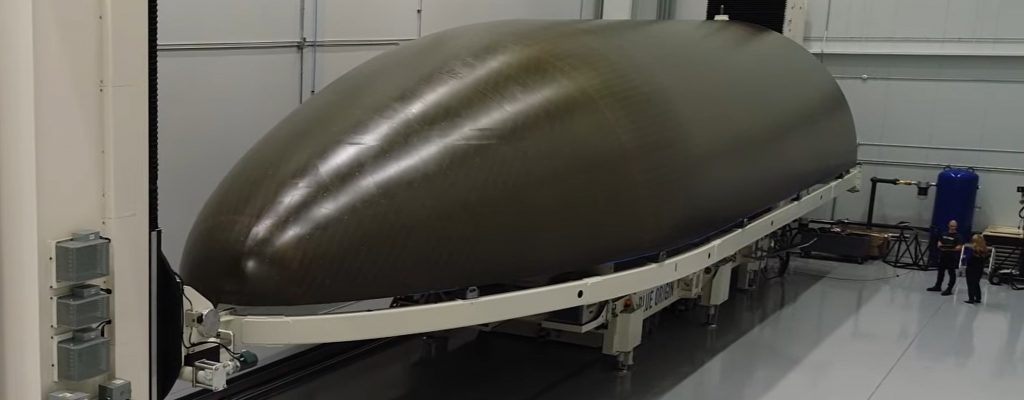
But the true star of the show, at long last, is an apparent full-scale prototype of New Glenn’s upper stage. At minimum, Blue Origin’s first ‘test tank’ (using SpaceX parlance) should allow the company to finally verify the performance of New Glenn’s aluminum tank barrel sections and domes under cryogenic (ultra-cold) conditions. It’s unclear how (or if) Blue Origin intends to complete integrated static-fire testing of New Glenn’s upper stage before the rocket’s first launch, but it’s possible that the tank it finally delivered was designed to support testing with and without engines.
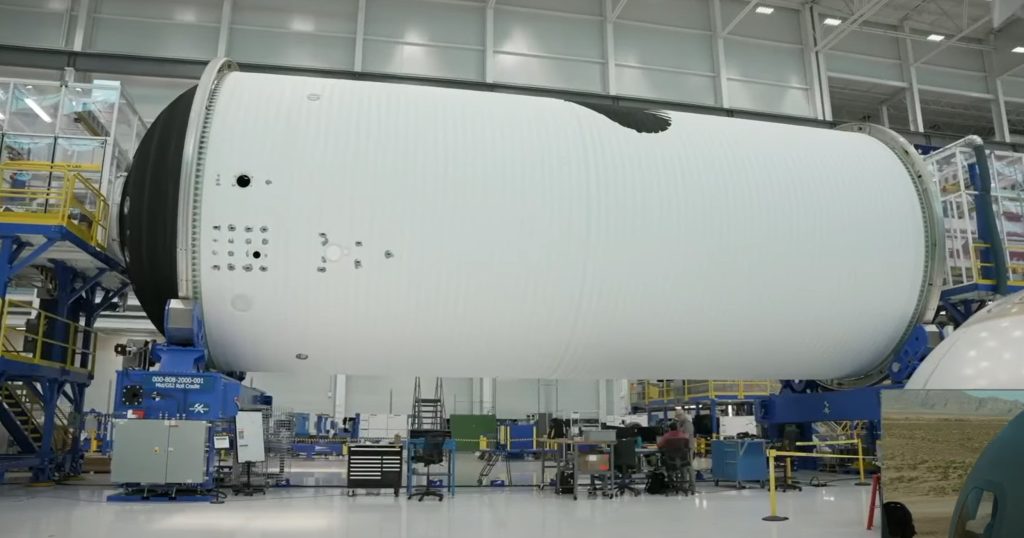
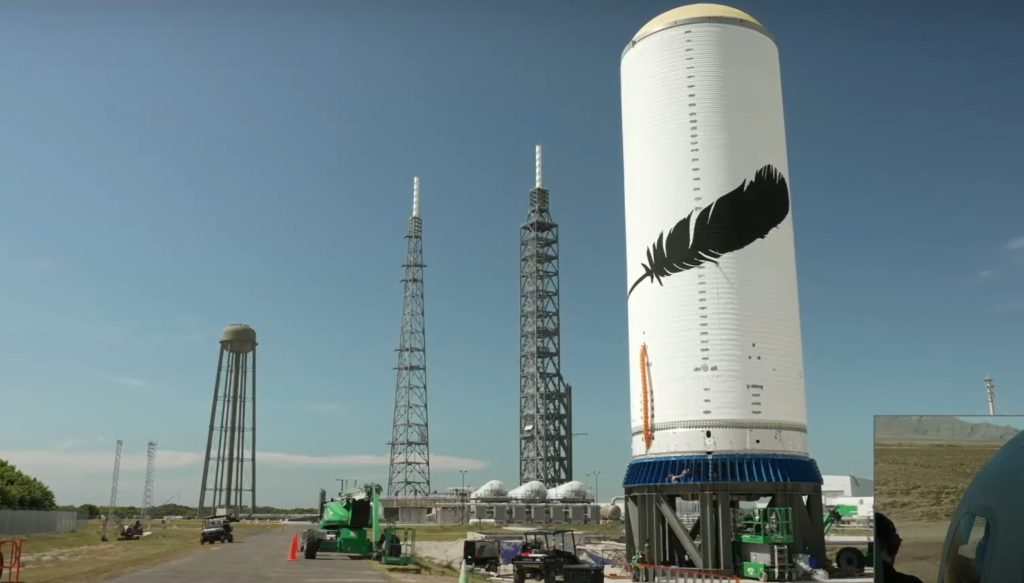
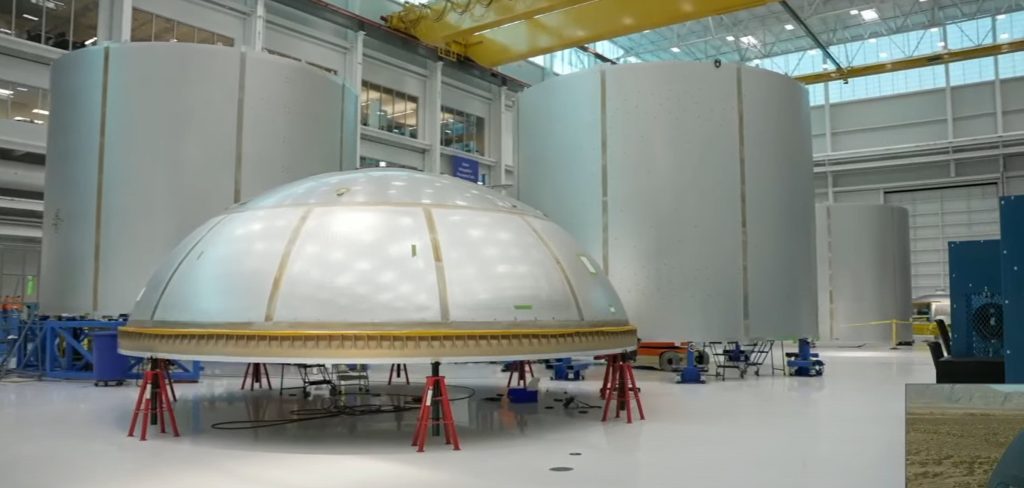
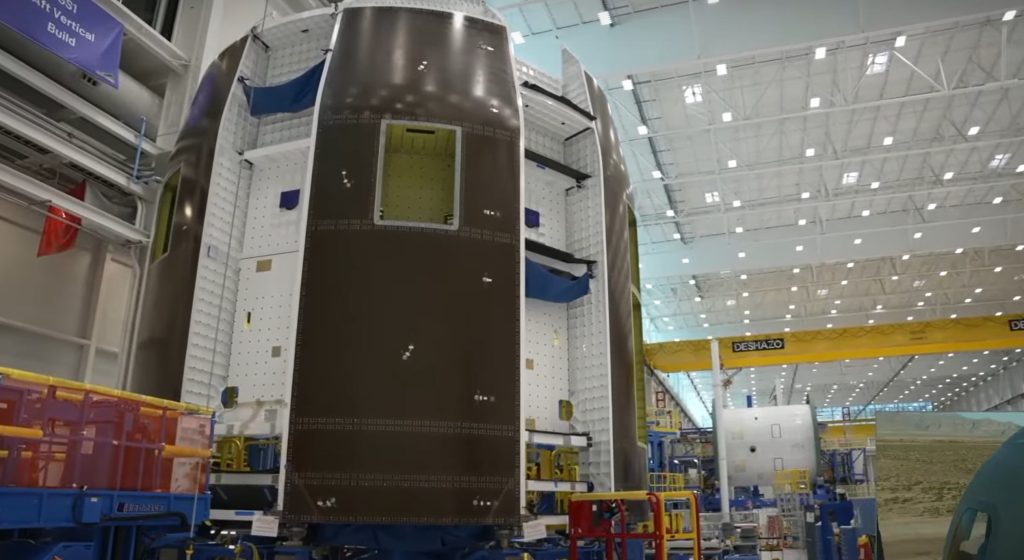
Nonetheless, Blue Origin hasn’t specified what it actually plans to do with its first New Glenn test tank and it’s even less clear why it has taken the company so long to complete one. While difficult, the methods Blue Origin is using to build New Glenn’s primary structures are about as standard as they get for modern rockets. Blue Origin itself even uses the same tech to build its smaller New Shepard rockets. So does SpaceX, ULA, Boeing, Arianespace, and virtually every other manufacturer of medium-to-large rockets, including NASA’s Space Launch System (SLS) core stage, which is wider than New Glenn.
The results of those challenges (managerial, technical, or otherwise) are clear: Blue Origin is nowhere close to debuting its next-generation rocket while competitors like Arianespace and ULA are tracking towards H1 2023 debuts of their Ariane 6 and Vulcan rockets. SpaceX, who is pursuing full reusability and really only settled on the design of its larger rocket in 2019, could even be ready to attempt an orbital-class launch with Starship before the end of 2022.
Still, the long-awaited beginning of hardware-rich New Glenn development appears to have finally arrived, and it’s possible that Blue Origin’s first orbital-class rocket could finally start picking up momentum towards its launch debut.

News
Tesla aims to combat common Full Self-Driving problem with new patent
Tesla writes in the patent that its autonomous and semi-autonomous vehicles are heavily reliant on camera systems to navigate and interact with their environment.

Tesla is aiming to combat a common Full Self-Driving problem with a new patent.
One issue with Tesla’s vision-based approach is that sunlight glare can become a troublesome element of everyday travel. Full Self-Driving is certainly an amazing technology, but there are still things Tesla is aiming to figure out with its development.
Unfortunately, it is extremely difficult to get around this issue, and even humans need ways to combat it when they’re driving, as we commonly use sunglasses or sun visors to give us better visibility.
Cameras obviously do not have these ways to fight sunglare, but a new patent Tesla recently had published aims to fight this through a “glare shield.”
Tesla writes in the patent that its autonomous and semi-autonomous vehicles are heavily reliant on camera systems to navigate and interact with their environment.

The ability to see surroundings is crucial for accurate performance, and glare is one element of interference that has yet to be confronted.
Tesla described the patent, which will utilize “a textured surface composed of an array of micro-cones, or cone-shaped formations, which serve to scatter incident light in various directions, thereby reducing glare and improving camera vision.”

The patent was first spotted by Not a Tesla App.
The design of the micro-cones is the first element of the puzzle to fight the excess glare. The patent says they are “optimized in size, angle, and orientation to minimize Total Hemispherical Reflectance (THR) and reflection penalty, enhancing the camera’s ability to accurately interpret visual data.”
Additionally, there is an electromechanical system for dynamic orientation adjustment, which will allow the micro-cones to move based on the angle of external light sources.
This is not the only thing Tesla is mulling to resolve issues with sunlight glare, as it has also worked on two other ways to combat the problem. One thing the company has discussed is a direct photon count.
CEO Elon Musk said during the Q2 Earnings Call:
“We use an approach which is direct photon count. When you see a processed image, so the image that goes from the sort of photon counter — the silicon photon counter — that then goes through a digital signal processor or image signal processor, that’s normally what happens. And then the image that you see looks all washed out, because if you point the camera at the sun, the post-processing of the photon counting washes things out.”
Future Hardware iterations, like Hardware 5 and Hardware 6, could also integrate better solutions for the sunglare issue, such as neutral density filters or heated lenses, aiming to solve glare more effectively.
Elon Musk
Delaware Supreme Court reinstates Elon Musk’s 2018 Tesla CEO pay package
The unanimous decision criticized the prior total rescission as “improper and inequitable,” arguing that it left Musk uncompensated for six years of transformative leadership at Tesla.

The Delaware Supreme Court has overturned a lower court ruling, reinstating Elon Musk’s 2018 compensation package originally valued at $56 billion but now worth approximately $139 billion due to Tesla’s soaring stock price.
The unanimous decision criticized the prior total rescission as “improper and inequitable,” arguing that it left Musk uncompensated for six years of transformative leadership at Tesla. Musk quickly celebrated the outcome on X, stating that he felt “vindicated.” He also shared his gratitude to TSLA shareholders.
Delaware Supreme Court makes a decision
In a 49-page ruling Friday, the Delaware Supreme Court reversed Chancellor Kathaleen McCormick’s 2024 decision that voided the 2018 package over alleged board conflicts and inadequate shareholder disclosures. The high court acknowledged varying views on liability but agreed rescission was excessive, stating it “leaves Musk uncompensated for his time and efforts over a period of six years.”
The 2018 plan granted Musk options on about 304 million shares upon hitting aggressive milestones, all of which were achieved ahead of time. Shareholders overwhelmingly approved it initially in 2018 and ratified it once again in 2024 after the Delaware lower court struck it down. The case against Musk’s 2018 pay package was filed by plaintiff Richard Tornetta, who held just nine shares when the compensation plan was approved.
A hard-fought victory
As noted in a Reuters report, Tesla’s win avoids a potential $26 billion earnings hit from replacing the award at current prices. Tesla, now Texas-incorporated, had hedged with interim plans, including a November 2025 shareholder-approved package potentially worth $878 billion tied to Robotaxi and Optimus goals and other extremely aggressive operational milestones.
The saga surrounding Elon Musk’s 2018 pay package ultimately damaged Delaware’s corporate appeal, prompting a number of high-profile firms, such as Dropbox, Roblox, Trade Desk, and Coinbase, to follow Tesla’s exodus out of the state. What added more fuel to the issue was the fact that Tornetta’s legal team, following the lower court’s 2024 decision, demanded a fee request of more than $5.1 billion worth of TSLA stock, which was equal to an hourly rate of over $200,000.
Delaware Supreme Court Elon Musk 2018 Pay Package by Simon Alvarez
News
Tesla Cybercab tests are going on overdrive with production-ready units
Tesla is ramping its real-world tests of the Cybercab, with multiple sightings of the vehicle being reported across social media this week.

Tesla is ramping its real-world tests of the Cybercab, with multiple sightings of the autonomous two-seater being reported across social media this week. Based on videos of the vehicle that have been shared online, it appears that Cybercab tests are underway across multiple states.
Recent Cybercab sightings
Reports of Cybercab tests have ramped this week, with a vehicle that looked like a production-ready prototype being spotted at Apple’s Visitor Center in California. The vehicle in this sighting was interesting as it was equipped with a steering wheel. The vehicle also featured some changes to the design of its brake lights.
The Cybercab was also filmed testing at the Fremont factory’s test track, which also seemed to involve a vehicle that looked production-ready. This also seemed to be the case for a Cybercab that was spotted in Austin, Texas, which happened to be undergoing real-world tests. Overall, these sightings suggest that Cybercab testing is fully underway, and the vehicle is really moving towards production.
Production design all but finalized?
Recently, a near-production-ready Cybercab was showcased at Tesla’s Santana Row showroom in San Jose. The vehicle was equipped with frameless windows, dual windshield wipers, powered butterfly door struts, an extended front splitter, an updated lightbar, new wheel covers, and a license plate bracket. Interior updates include redesigned dash/door panels, refined seats with center cupholders, updated carpet, and what appeared to be improved legroom.
There seems to be a pretty good chance that the Cybercab’s design has been all but finalized, at least considering Elon Musk’s comments at the 2025 Annual Shareholder Meeting. During the event, Musk confirmed that the vehicle will enter production around April 2026, and its production targets will be quite ambitious.








